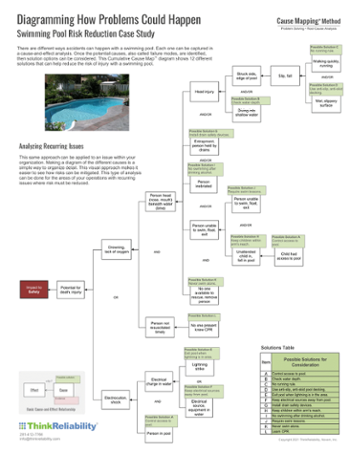A case study - Identifying swimming pool risks
Typically, an incident investigation or root cause analysis happens once a problem has occurred. It is possible, however, to capture the different ways a problem could occur in the future. Many people recognize this forward-looking approach as a Failure Modes Effects Analysis (FMEA), or a Process Hazards Analysis (PHA). The specific cause-and-effect relationships from the potential issue can also be captured on a cumulative Cause Map™ diagram. This example looks at swimming pool hazards, but the logic applies to any area of your operations where risk needs to be lower.
Let's say you’ve decided to install a swimming pool at your house. The potential hazards of pool ownership can be captured on a cumulative Cause Map™ diagram. Solutions can then be identified for each of the potential hazards to mitigate the risk of an incident. Just like defensive driving, think of it as “defensive pool safety.” At work, you’d only do this type of exercise for areas where you want to significantly reduce the likelihood of a negative outcome. If reducing risk is not important then capturing the causes is unnecessary.
Pool and water hazards
According to the Centers for Disease Control and Prevention (CDC), drowning is the leading cause of unintentional death for children ages 1-4. From 2005-2014, there were an average of 3,536 unintentional drownings (non-boating related) annually in the United States — about ten deaths per day1. Preventing pool injuries is extremely important. Obviously, drowning is a concern when discussing pool safety, but the other major incidents around pools are head injuries, slips and electrocution. We'll look at each of these accident types and discuss prevention methods.
Drowning
Drowning occurs when a person in the water is unable to get a breath and is not resuscitated in time. A child will lose consciousness after 2 minutes of being submerged and will suffer irreversible brain damage within 4-6 minutes. Some reasons a person may be unable to exit the water are that they are held underwater by the suction from drains (entrapment), they are too young to get out themselves, they are inebriated, or they don't know how to swim. In all cases, if another capable person were present to help, the injury or death could be avoided. A person may not be resuscitated if no one present knows how to perform CPR.
Other injuries
Head injuries around pools most commonly occur when people dive into shallow water. Slipping can occur anywhere around the pool. However, it is more likely when a person is walking quickly or running and when the area around the pool is wet and slippery (which might be prevented with anti-slip, anti-skid decking). Also, electrocution can occur when an electrical charge is introduced to the pool. This can occur from lightning or any electrical tool or appliance.
Diagramming Pool and Water Hazard Risks
Let's say you’ve decided to install a swimming pool at your house. The potential hazards of pool ownership can be captured on a cumulative Cause Map diagram using Cause Mapping® root cause analysis, which can be used reactively and proactively. An analysis can also be done proactively by identifying all the possible causes that could produce an incident. This collection of different ways an incident can happen in the future is a cumulative Cause Map diagram. It’s a simple, intuitive format for organizing detail.
Once the risks are mapped, solutions can then be identified for each of the potential hazards to mitigate the risk of an incident. Just like defensive driving, think of it as “defensive pool safety.” At work, you’d only do this type of exercise for areas where you want to significantly reduce the likelihood of a negative outcome. If reducing risk is not important, then capturing the causes is unnecessary.
Preventing pool accidents
Using this method, 12 possible solutions were identified to reduce the risk of accidents happening in and around a pool. To view the cumulative Cause Map diagram and the possible solutions, click on the thumbnail below.
Additional solutions could be proposed depending on the specific scenario. Some of the solutions identified affect the people using the pool: establish rules at the pool, learn CPR and require swimming lessons. Some solutions focus on the physical aspects of the pool and surrounding area design: control access (build a fence/barrier), use anti-slip, anti-skid decking, and install safety or dual drains. And some of the solutions improve upon how people use the pool: check water depth before diving, exit pool if lightning is in the area and keep children under a certain age, who can’t swim, within an arm’s distance of an adult.
Lowering risk
Spending time at the pool is fun for all ages. By considering all the things that could go (and have gone) wrong, there are proactive ways to reduce the risk of accidents happening. This same approach applies to any issue you want less of or more of in your business. You can reduce or increase the likelihood of whatever is important and valuable to your business.
To learn more about how to apply Cause Mapping® root cause analysis within your group contact our office or attend one of our free webinars.
1.Centers for Disease Control and Prevention, National Center for Injury Prevention and Control. Web-based Injury Statistics Query and Reporting System (WISQARS) [online]. [cited 2012 May 3]. Available from: URL: http://www.cdc.gov/injury/wisqars.
Additional root cause analysis resources:














